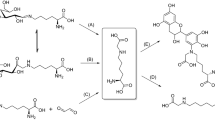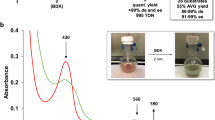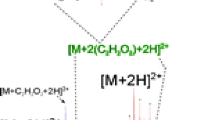Abstract
The relative roles of the two structural aspects of nonenzymic glycation sites of hemoglobin A, namely the ease with which the amino groups could form the aldimine adducts and the propensity of the microenvironments of the respective aldimines to facilitate the Amadori rearrangement, in dictating the site selectivity of nonenzymic glycation with aldotriose has been investigated. The chemical reactivity of the amino groups of hemoglobin A forin vitro reductive glycation with aldotriose is distinct from that in the nonreductive mode. The reactivity of amino groups of hemoglobin A toward reductive glycation (i.e., propensity for aldimine formation) decreases in the order Val-1(β), Val-1(α), Lys-66(β), Lys-61(α), and Lys-16(α). The overall reactivity of hemoglobin A toward nonreductive glycation decreased in the order Lys-16(α), Val-1(β), Lys-66(β), Lys-82(β), Lys-61(α), and Val-1(α). Since the aldimine is the common intermediate for both the reductive and nonreductive modification, the differential selectivity of protein for the two modes of glycation is clearly a reflection of the propensity of the microenvironments of nonenzymic glycation sites to facilitate the isomerization reaction (i.e., Amadori rearrangement). A semiquantitative estimate of this propensity of the microenvironment of the nonenzymic glycation sites has been obtained by comparing the nonreductive (nonenzymic) and reductive modification at individual glycation sites. The microenvironment of Lys-16(α) is very efficient in facilitating the rearrangement and the relative efficiency decreases in the order Lys-16(α), Lys-82(β), Lys-66(β), Lys-61(α), Val-1(β), and Val-1(α). The propensity of the microenvironment of Lys-16(α) to facilitate the Amadori rearrangement of the aldimine is about three orders of magnitude higher than that of Val-1(α) and is about 50 times higher than that of Val-1(β). The extent of nonenzymic glycation at the individual sites is modulated by various factors, such as thepH, concentration of aldotriose, and the concentration of the protein. The nucleophiles—such as tris, glycine ethyl ester, and amino guanidine—inhibit the glycation by trapping the aldotriose. The nonenzymic glycation inhibitory power of nucleophile is directly related to its propensity to form aldimine. Thus, the extent of inhibition of nonenzymic glycation at a given site by a nucleophile directly reflects the relative role ofpKa of the site in dictating the glycation at that site. The nonenzymic glycation of an amino group of a protein is an additive/synergestic consequence of the propensity of the site to form aldimine adducts on one hand, and the propensity of its microenvironment to facilitate the isomerization of the aldimines to ketoamines on the other. The isomerization potential of microenvironment plays the dominant role in dictating the site specificity of the nonenzymic glycation of proteins.
Similar content being viewed by others
References
Abraham, E., Tsai, C., Abraham, A., and Swamy, M. (1989). InBirkhauser Reports, Birkhauser-Verlag A.G, Basel, Switzerland (in press).
Acharya, A. S. (1987). InModern Methods in Protein Structural Analysis, J. L'italicm, Plenum Press, New York, p. 168.
Acharya, A. S., and Manning, J. M. (1980).J. Biol. Chem. 255, 1406–1412.
Acharya, A. S., and Manning, J. M. (1980).J. Biol. Chem. 255, 7218–7224.
Acharya, A. S., and Manning, J. M. (1983).Proc. Natl. Acad. Sci. 80, 3590–3594.
Archarya, A. S., and Manjula, B. N. (1987).Biochemistry 26, 3524–3530.
Acharya, A. S., and Sussmann, L. G. (1984).J. Biol. Chem. 259, 4372–4378.
Archarya, A. S., Cho, Y. J., and Dorai, B. (1989).Ann. N. Y. Acad. Sci. 565, 349–352.
Acharya, A. S., Cho, Y. J., and Manjula, B. N. (1988).Biochemistry 27, 4522–4529.
Acharya, A. S., Sussman, L. G., and Manning, J. M. (1983).J. Biol. Chem. 258, 2296–2302.
Bai, Y., Ueno, H., and Manning, J. M. (1989).J. Prot. Chem. 8, 299–315.
Benesch, R. E., Benesch, R., Renthal, R. D., and Maeda (1972).Biochemistry 11, 3576–3582.
Bookchin, R. M., and Gallop, P. M. (1988).Biochem. Biophys. Res. Communs. 32, 86.
Brownlee, M., Vlassara, H., Kooney, A., Ulrich, P., and Cerami, A. (1986).Science 232, 1629–1632.
Bunn, H. F., Haney, D. N., Gabbay, K. H., and Gallop, P. M. (1975).Biochem. Biophys. Res. Communs. 67, 103–109.
Bunn, H. F., and Higgins, P. J. (1981).Science 213, 222–224.
Feeney, R. E., Blackenhorn, G., and Dixon, H. B. F. (1975).Adv. Prot. Chem. 29, 135–203.
Gabbay, K. H., Sosenko, J. M., Banuchi, G. A., Minnisonn, M. J., and Flukinger, R. (1979).Diabetes 28, 337.
Garlick, R. L., and Mazur, J. L. (1983).J. Biol. Chem. 258, 6142–6146.
Hodge, J. E. (1955).Adv. Carbohydrate Chem. 10, 169–305.
Holmquist, W. R., and Schroeder, W. A. (1966).Biochemistry 5, 2489.
Iberg, N., and Flukinger, R. (1986).J. Biol. Chem. 261, 13,542–13,545.
Kassiakoff, A. A. (1988).Science 240, 191.
Lolis, E., and Petsko, G. A. (1990).Ann. Rev. Bioch. 59, 597–630.
McDonald, M. J., Shapiro, R., Bleichman, M., Solway, J., and Bunn, H. F. (1978).J. Biol. Chem. 253, 2327–2332.
McPherson, J. D., Shilton, B., and Walton, D. J. (1988).Biochemistry 27, 1901–1907.
Mori, N., Bai, Y., Ueno, H., and Manning, J. M. (1989).Carbohydrate Research 189, 49–63.
Mori, N., and Manning, J. M. (1986).Anal. Biochem. 152, 396–401.
Nigen, A., and Manning, J. M. (1977).Proc. Natl. Acad. Sci. USA.74, 367–371.
Perutz, M. F., Fogg, J. H., and Fox, J. A. (1980).J. Mol. Biol. 138, 699.
Robinson, A. B., and Tedro, S. (1973).Int. J. Pep and Prot. Res. 5, 275.
Robinson, A. B., Scotchler, J. W., and McKarrow, J. H. (1973).J. Am. Chem. Soc. 95, 8156.
Shapiro, R., McManus, M. J., Zalut, C., and Bunn, H. F. (1980).J. Biol. Chem. 255, 3120–3127.
Suarez, G., Rajaram, R., Oronsky, A. L., and Gawinowicz, M. A. (1989).J. Biol. Chem. 264, 3674–3679.
Wearme, S. J., and Creighton, T. E. (1989).Proteins 5, 8.
Watkins, N. G., Thorpe, S. R., and Baynes, J. W. (1987).J. Biol. Chem. 262, 7207–7212.
Wold, F. (1981).Ann. Rev. Biochem. 50, 783–837.
Author information
Authors and Affiliations
Rights and permissions
About this article
Cite this article
Acharya, A.S., Roy, R.P. & Dorai, B. Aldimine to ketoamine isomerization (Amadori rearrangement) potential at the individual nonenzymic glycation sites of hemoglobin a: Preferential inhibition of glycation by nucleophiles at sites of low isomerization potential. J Protein Chem 10, 345–358 (1991). https://doi.org/10.1007/BF01025633
Received:
Published:
Issue Date:
DOI: https://doi.org/10.1007/BF01025633




